![]()
![]()
![]()
Use LEFT and RIGHT arrow keys to navigate between flashcards;
Use UP and DOWN arrow keys to flip the card;
H to show hint;
A reads text to speech;
20 Cards in this Set
- Front
- Back
|
Define homeostasis |
The regulation of the internal conditions of a cell or organism to maintain optimal conditions for function in response to internal and external changes. |
|
|
What are the 2 things that homeostasis maintain optimal conditions for? |
1. Enzyme action 2. All cell functions |
|
|
In the human body what are the 3 things that homeostasis controls? |
1. Blood glucose concentration 2. Body temperature 3. Water levels |
|
|
What are the 2 different types of automatic controls systems in the human body? |
1. Nervous (electrical) responses 2. Chemical (hormonal) responses |
|
|
What are the 3 things that all control systems include? |
1. Receptor cells 2. Coordination centres 3. Effectors |
|
|
What is the function of a receptor cell? |
To detect stimuli (changes in the environment). |
|
|
What are the coordination centres of the central nervous system? |
Brain and spinal cord |
|
|
What is the coordination centre in the control of blood glucose? |
The pancreas |
|
|
What are the coordination centres of the menstrual cycle? |
The pituitary gland and the ovaries. |
|
|
What do coordination centres do? |
They receive and process information from receptor cells. |
|
|
What are the two types of effects and what do they each do? |
Muscles and glands. Muscles contract or relax Glands either release or stop releasing hormones. These actions restore the optimum levels. |
|
|
What is the function of the nervous system? |
To enable humans to react to their surroundings and coordinate their behaviour. |
|
|
S R C E R Skinny Rabbits Can Eat Rats |
Stimulus Receptor Coordinator Effector Response |
|
|
Name the 3 neurones in a reflex arc and explain their function |
Sensory neurone - carries electrical impulse from receptor cell to coordinator. Relay neurone - is in the brain or spinal and coordinates the response. Motor neurone - carries electrical impulse from coordinator to effector, which brings about a response. |
|
|
What are the 3 main features of reflex responses and why are reflex responses important? |
Automatic Rapid Don’t involve the conscious parts of the brain They are important because they protect us from danger. |
|
|
What is a synapse and how is information passed across one? |
A gap between 2 neurones. When an electrical impulse reaches the end of a neurone, chemicals are released from the neurone that diffuse across the synapse. The chemicals bind to the next neurone and trigger an electrical impulse in that neurone. |
|
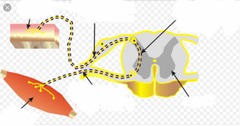
Label |
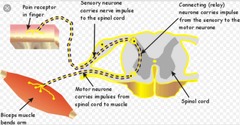
Back (Definition) |
|
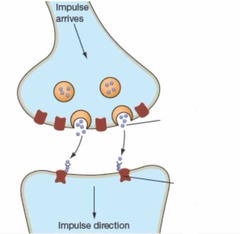
Describe what is happening at this synapse |
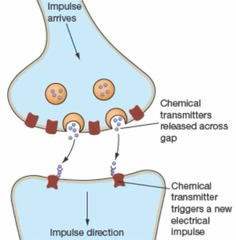
Back (Definition) |
|
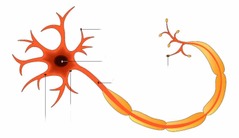
Label the neurone |

Back (Definition) |
|
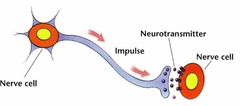
Describe what happens to trigger a response in a reflex reaction |
The receptor cell detects a change in the environment which triggers an electrical impulse to pass along the sensory, then relay, them motor neurones. At the end of the motor neurone is either a muscle which contracts or a gland which secretes a hormone to bring about the desired response. |

